5 Implementation of monetary policy
5.1 Monetary policy guidelines
Pursuant to section 1 of the Norges Bank Act, Norges Bank shall be an executive and advisory body for monetary, credit and foreign exchange policy. The Bank shall issue banknotes and coins, promote an efficient payment system and monitor the money, credit and foreign exchange markets.
The current monetary policy guidelines were introduced by regulation on 29 March 2001; see Box 6.1. The guidelines were explained and expanded on in Report No. 29 (2000–2001) to the Storting on economic policy guidelines, published the same day.
Textbox 5.1 Regulation on monetary policy
Established by Royal Decree of 29 March 2001 pursuant to section 2, third paragraph, and section 4, second paragraph, of the Norges Bank Act.
I
Section 1
Monetary policy shall be aimed at stability in the Norwegian krone’s national and international value, contributing to stable expectations concerning exchange rate developments. At the same time, monetary policy shall underpin fiscal policy by contributing to stable developments in output and employment.
Norges Bank is responsible for the implementation of monetary policy.
Norges Bank’s implementation of monetary policy shall, in accordance with the first paragraph, be oriented towards low and stable inflation. The operational target of monetary policy shall be annual consumer price inflation of approximately 2.5 percent over time.
In general, the direct effects on consumer prices resulting from changes in interest rates, taxes, excise duties and extraordinary temporary disturbances shall not be taken into account.
Section 2
Norges Bank shall regularly publish the assessments that form the basis for the implementation of monetary policy.
Section 3
The international value of the Norwegian krone is determined by the exchange rates in the foreign exchange market.
Section 4
On behalf of the State, Norges Bank communicates the information concerning the exchange rate system ensuing from its participation in the International Monetary Fund; see section 25, first paragraph, of the Act on Norges Bank and the Monetary System.
II
This regulation comes into force immediately. Regulation No. 0331 of 6 May 1994 on the exchange rate system for the Norwegian krone is repealed from the same date.
According to the regulations, Norges Bank’s implementation of monetary policy must focus on low, stable inflation, defined as annual growth in consumer prices which over time is close to 2.5 percent. Report No. 29 (2000–2001) further stated that Norges Bank must adopt a forward-looking approach when setting the interest rate, and take sufficient account of uncertainty associated with macroeconomic forecasts and assessments. When the Executive Board of Norges Bank sets the interest rate, it must take into account that it may take time for changes in policy to take effect.
The long-term task of monetary policy is to help give the economy a nominal anchor point. The regulations established flexible inflation targeting as a guideline for monetary policy. In the short and medium term, Norges Bank must balance the consideration of low, stable inflation with the consideration of stability in output and employment. Often, there is no conflict between these two considerations. If a conflict arises, Norges Bank must exercise discretion and weight the two considerations against one another.
5.2 Instruments and balancing exercises in the context of monetary policy
The most important instrument in the conduct of monetary policy is the key policy rate, i.e. the interest rate on banks’ overnight deposits with Norges Bank. In normal circumstances, changes in the key policy rate have a strong effect on the very short-term money market rates. Market rates for loans and investments with longer terms are influenced by the level of the key policy rate and by the expectations of market participants regarding the future development of the key policy rate.
Market expectations regarding the key policy rate depend on the market participants’ beliefs concerning economic developments, particularly in relation to growth and price rises, and their view on the central bank’s future actions. Market rates influence the krone exchange rate, the prices of securities, housing prices and demand for loans, investment and consumption. Norges Bank’s key policy rate also influences expectations regarding economic developments and future inflation. Through all of these channels, the interest rate influences the total demand and output situation, as well as prices and wages.
In its 2015 Annual Report, Norges Bank wrote, among other things, the following about flexible inflation targeting:
Norges Bank seeks to maintain inflation close to 2.5% over time. In its conduct of monetary policy, Norges Bank operates a flexible inflation targeting regime, so that weight is given to both variability in inflation and variability in output and employment when setting the key policy rate.
Norges Bank publishes their Monetary Policy Report four times a year, simultaneously with the interest rate decisions of the Executive Board. In the reports, Norges Bank analyses the economic situation and developments. The reports also contain Norges Bank’s assessments of the counter-cyclical capital buffer; see the discussion in chapter 2.
Norges Bank publishes forecasts of future developments, including forecast for the key policy rate. The bank describes how different monetary policy considerations are balanced. If Norges Bank’s monetary policy actions are regarded as stable and credible, the effect of monetary policy is also strengthened. Norges Bank has developed a set of criteria for what the bank considers to be a good future development of the interest rate. The criteria are discussed in the Monetary Policy Reports.
The implementation of monetary policy requires good access to information about economic developments. Since 2002, Norges Bank has gathered information about output and price trends and planned investment and employment levels from its own regional network of firms and public enterprises. Around 1,500 contacts are linked through this network. Along with available official statistics, the reports from the regional network constitute an important part of the Bank’s decision-making basis.
5.3 Implementation of monetary policy in 2015
Monetary policy takes effect with a time lag. Developments in inflation, output and employment in 2015 are therefore also influenced by the monetary policy pursued in preceding years.
At the interest rate meeting in December 2014, Norges Bank reduced the key policy rate by 0.25 percentage points, to 1.25 percent. The key policy rate strategy adopted by the Executive Board in the December 2014 Monetary Policy Report was that the interest rate should lie in the interval ¾–1¾ percent in the period until publication of the next report in March 2015, unless the Norwegian economy was exposed to major new shocks.
Prior to the March interest rate meeting, several central banks, including the European Central Bank (ECB) and Sveriges Riksbank, implemented further monetary policy easing. Growth among trading partners was moderate, and approximately as forecasted in the December 2014 Monetary Policy Report. Both oil prices and the Norwegian krone developed somewhat weaker than anticipated. According to Norges Bank, the Norwegian economy developed generally as expected, although the future outlook was weaker than previously assumed. At the interest rate meeting in March, Norges Bank emphasised that the key policy rate had been cut in December 2014 to counter the risk of a sharp weakening of the Norwegian economy due to falling oil prices. Until then, the impact on the real economy had been relatively small. Following an overall assessment, the Executive Board decided to keep the key policy rate unchanged at 1.25 percent. In Monetary Policy Report 1/15 (PPR 1/15), the bank presented a key policy rate projection indicating that the rate would lie around 1 percent for the next few years, before increasing gradually. The key policy rate projection was lower than in December 2014, for the entire projection period.
During the spring, growth among trading partners was slightly weaker than forecasted in PPR 1/15. Nevertheless, growth in the Norwegian economy was about as expected. The outcome of the wage settlement process indicated that wage growth in 2015 would be lower than estimated. Housing prices had continued to rise, and household debt growth was higher than expected. Consumer price inflation was close to 2.5 percent, approximately as forecasted. At the interest rate meeting in May, the Executive Board decided to keep the key policy rate unchanged at 1.25 percent.
Prior to the interest rate meeting in June, growth among trading partners was weaker than anticipated. In June, oil prices lay between USD 60 and USD 65 per barrel, i.e. a little higher than assumed in the March Monetary Policy Report. Thus far in the quarter, the Norwegian krone had developed as projected by Norges Bank in PPR 1/15, although it depreciated in the weeks preceding the interest rate meeting. New information indicated that growth in the Norwegian economy was a little weaker than expected, and Norges Bank also considered the future outlook to have weakened. Consumer price inflation had fluctuated between 2 and 2.5 percent recently. Norges Bank pointed out that the depreciation of the krone was likely to raise inflation for a period of time, but that longer-term inflation would be dampened by the drop in the wage growth. At the June interest rate meeting, Norges Bank emphasised that longer-term growth prospects and inflation drivers had weakened. Following an overall assessment, the Executive Board decided to cut the key policy rate by 0.25 percentage points, to 1.0 percent. In Monetary Policy Report 2/15, the bank presented a key policy rate projection indicating that the rate would lie just above ¾ percent for the next year, before increasing gradually. The key policy rate projection was somewhat lower than in March 2015 for the period until the second half of 2017, but a little higher towards the end of the projection period.
Oil prices fell throughout the summer. The Norwegian krone depreciated sharply, and was weaker than forecasted in the June Monetary Policy Report. Estimated growth among Norway’s trading partners was somewhat lower than in June, and prices in the interest rate market indicated further postponement of the expected rise in foreign interest rates. Growth in the Norwegian economy was approximately as predicted in PPR 2/15, although the future growth outlook appeared weaker. Consumer price inflation was higher than forecasted by Norges Bank in June. At the interest rate meeting in September, the Executive Board of Norges Bank emphasised that the decline in oil prices would slow the growth in the Norwegian economy. It was pointed out that the krone depreciation was likely to boost consumer price inflation in the short term, but that inflation was expected to fall in the longer term. At the September interest rate meeting, the Executive Board decided to cut the key policy rate by 0.25 percentage points, to 0.75 percent. The bank also published a projection for the key policy rate indicating that it would fall to just over ½ percent in 2016. The key policy rate projection was lower than in June 2015, for the entire projection period.
In the period leading up to the November interest rate meeting, trading partners’ growth was approximately as forecasted in Monetary Policy Report 3/15. Several central banks had signalled further monetary policy easing. Oil prices developed generally as expected by Norges Bank, although the krone was weaker than forecasted in PPR 3/15. Growth in the Norwegian economy was slightly weaker than anticipated. At the interest rate meeting in November, following an overall assessment, Norges Bank decided to keep the key policy rate unchanged, at 0.75 percent.
Oil prices continued to decline after the November interest rate meeting, falling just below USD 40 per barrel in December 2015. There were prospects of slightly higher growth among trading partners, about as forecasted in PPR 3/15. The Norwegian economy’s growth in December was in line with Norges Bank’s September estimates. However, there were signs that the oil-price drop was having an impact on other sectors of the Norwegian economy; ones which had continued to grow thus far. On the other hand, the krone’s depreciation improved the profitability of exporters and import-competing industry. Consumer price inflation was approximately as forecasted by Norges Bank in September. At its December interest rate meeting, the Executive Board emphasised that the Norwegian economy had developed generally as predicted in PPR 3/15. The future growth outlook was a little weaker than expected. However, the Executive Board also stated that uncertainty about the effect of monetary policy suggested that a gradual approach should be adopted in the interest rate setting. Following an overall assessment, Norges Bank decided to keep the key policy rate unchanged, at 0.75 percent. In Monetary Policy Report 4/15, the bank presented a projection for the key policy rate indicating that it would decline to just under ½ percent in 2016. The key policy rate projection was lower than in September.
Table 5.1 Interest rate decisions of the Executive Board of Norges Bank in 2015
Interest rate meeting | Change in percentage points | Key policy rate post-meeting | Projection for the average of the key policy rate in 2017 |
|---|---|---|---|
March | 0.00 | 1.25 | 1 |
May | 0.00 | 1.25 | – |
June | -0.25 | 1.00 | 1 |
September | -0.25 | 0.75 | ½ |
November | 0.00 | 0.75 | – |
December | 0.00 | 0.75 | 0.4 |
Source Norges Bank
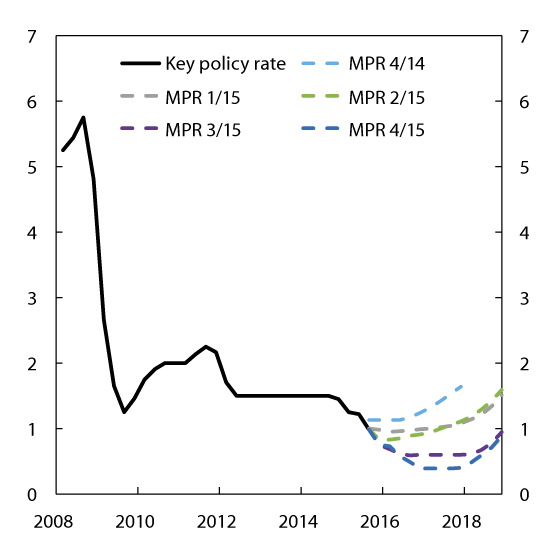
Figure 5.1 Projections for the key policy rate in various monetary police reports. Percent. 2008 Q1 – 2018 Q41
1 Figure 5.1 is identical to Figure 1.2 in Norges Bank’s annual report for 2015.
Source Norges Bank
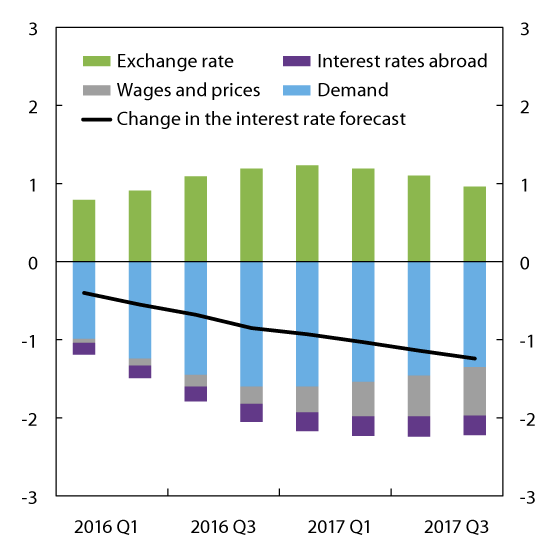
Figure 5.2 Factors behind changes in the interest rate forecast between MPR 4/14 and MPR 4/15. Percentage points. 2016 Q1 – 2017 Q41
1 Figure 5.2 is identical to Figure 1.7 in Norges Bank’s annual report for 2015.
Source Norges Bank
Figure 5.2 shows changes in the projected key policy rate from Monetary Policy Report 4/14 to Monetary Policy Report 4/15. Norges Bank reduced its key policy rate projection for the next three years throughout 2015. The bars show the individual contributions of different factors to changes in Norges Bank’s interest rate projection. The prospect of lower domestic demand and reduced wage growth both pulled the interest rate projection down during the course of the year, while the depreciation of the krone had the opposite effect.
5.4 Development of money-market risk premiums
Risk premiums in the Norwegian money market rose from 2014 to 2015. Measured as the difference between the three-month money market rate on loans denominated in Norwegian kroner and market participants’ expected key policy rate in the same period, the average premium was just above 30 basis points in 2015.
In its 2015 Annual Report, Norges Bank wrote the following regarding the reason for the increase in the risk premium:
Nibor panel banks base their daily Nibor quoting on a USD interest rate intended to reflect the banks’ cost of borrowing USD in the unsecured interbank market. The USD interest rate is adjusted for the forward premium between USD and NOK. With this construction of Nibor as a currency swap rate, external factors can have a contagion effect on Norwegian money market rates.
In 2015, the European Central Bank (ECB) decided to increase its securities purchases. This increased the supply of EUR relative to USD and raised the cost of swapping EUR for USD in the FX forward market. This indicates a higher premium in the Kliem USD interest rate, on which Nibor is based.
The forward premium between USD and NOK is influenced by the relative supply of USD and NOK. Low structural liquidity may make banks more uncertain of their own NOK liquidity situation. Periodically low structural liquidity, particularly towards the end of the year, is therefore likely to have contributed somewhat to the increase in premiums in 2015.
In recent years, the risk premium in the Norwegian money market has been higher in Norway than in many other countries. This fact is an important driver of the authorities’ efforts over several years to introduce structural measures for the Norwegian money market.
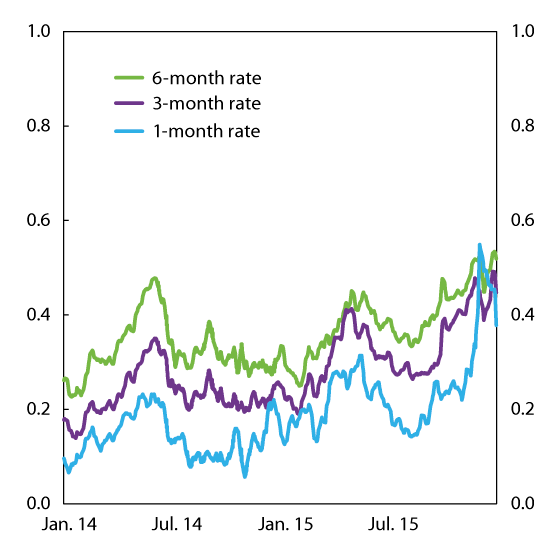
Figure 5.3 Spread between money market rates and expected key policy rate. Percentage points. 5-day moving average. 1 January 2014–31 December 20151
1 Figure 5.3 is identical to Figure 3.4 in Norges Bank’s annual report for 2015.
Source Norges Bank
Rules on the setting of Nibor and corresponding interest rates in other countries have largely been left to the involved banks and their organisations. However, misuse and manipulation have been uncovered in various other countries, and the credibility of Nibor has also been questioned. By Royal Decree of 4 December 2015, it was decided that the Act relating to the setting of benchmark rates (the Benchmark Rate Act) would be introduced on 1 January 2016. The Act is based on a consultation paper prepared by the Financial Supervisory Authority of Norway (Finanstilsynet), and its purpose is to make the setting of Norwegian benchmark rates subject to public regulation and supervision. The new act requires appropriate organisation of the setting of generally used benchmark rates, and approval of the administrator (the party responsible for setting the benchmark rate) and organisational arrangement by the Ministry of Finance. Finanstilsynet will supervise the setting of benchmark rates, and may order changes if such setting is found to be improper or otherwise contrary to the rules.
5.5 Developments in inflation, production, employment and the exchange rate
The consumer price index (CPI) may vary considerably from one month to the next, for example as a result of large fluctuations in electricity prices. Different indicators of underlying price growth attempt to eliminate consumer price changes occasioned by temporary disruptions. Consumer price inflation adjusted for tax changes and excluding energy products (CPI-ATE) is one such measure. Since 2008, Norges Bank has also calculated the CPIXE indicator of underlying inflation, in which CPI is adjusted for tax changes and temporary changes in energy prices. CPIXE seeks to incorporate any applicable energy price trends.
Consumer price inflation (CPI) totalled 2.1 percent from 2014 to 2015, up from 2.0 percent the previous year. The increase in CPI-ATE was 2.7 percent in 2015. Over the past five years, CPI has increased by an average of 1.7 percent per year. Figure 5.4 shows consumer price inflation in recent years.
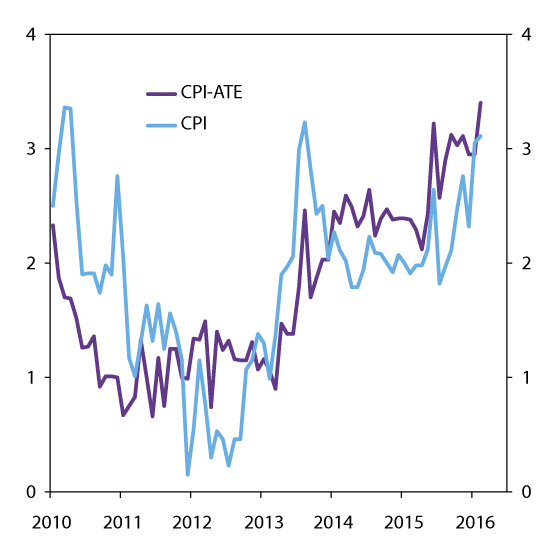
Figure 5.4 CPI and CPI-ATE. Twelve-month change. Percent. January 2010 – February 20161
1 Figure 5.4 is almost identical to Figure 1.33 in Norges Bank’s Monetary Policy Report 1/16.
Source Norges Bank.
In its 2015 Annual Report, Norges Bank wrote the following regarding the development of inflation over time:
Experience of flexible inflation targeting in Norway has been favourable. (…) Over the past 15 years, inflation has averaged somewhat below, but close to, 2.5%. The deviation from the inflation target may reflect a number of the supply-side characteristics of the 2000s, such as solid productivity growth, high labour immigration and a low rise in prices for imported consumer goods.
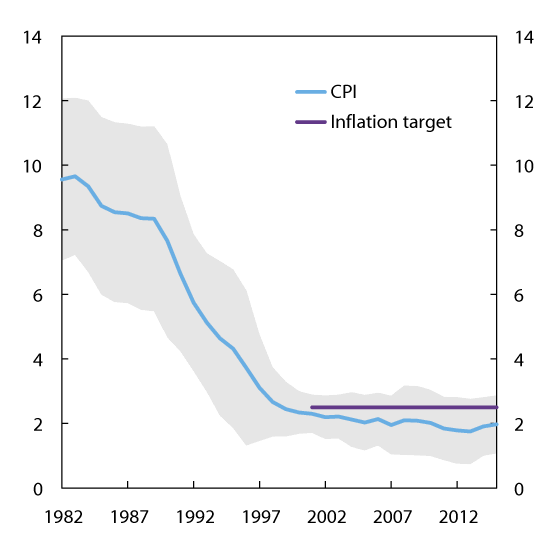
Figure 5.5 1 Inflation. 10-year moving2 average and variation3 in CPI. Percent. 1982 – 2015
1 Figure 5.5 is identical to Figure 1.3 in Norges Bank’s annual report for 2015.
2 The moving average is calculated over a ten-year period.
3 The band around CPI is the variation in CPI in the averaging period, measured by +/– one standard deviation.
Source Norges Bank
If participants in the economy have confidence that the central bank will achieve its inflation target, they will expect inflation to equal the target in the long run. In its 2015 Annual Report, Norges Bank stated the following:
The stabilising effect of monetary policy on developments in output and employment is dependent on confidence that the inflation target will be achieved. Inflation will not be at target at all times, but if there is confidence in monetary policy, expected inflation will be close to the inflation target over time, which in itself helps to stabilise inflation.
Norges Bank has engaged Epinion to conduct quarterly surveys on topics including expected inflation. Figure 5.6 shows the development in expected price growth in recent years. In the first quarter of 2016, economists expected consumer price inflation to be 2.3 percent in two years’ time and 2.2 percent in five years’ time. The social partners expected price growth of 2.6 percent in two years’ time and 2.7 percent in five years’ time. Households’ expectations for the price growth have normally been somewhat higher.
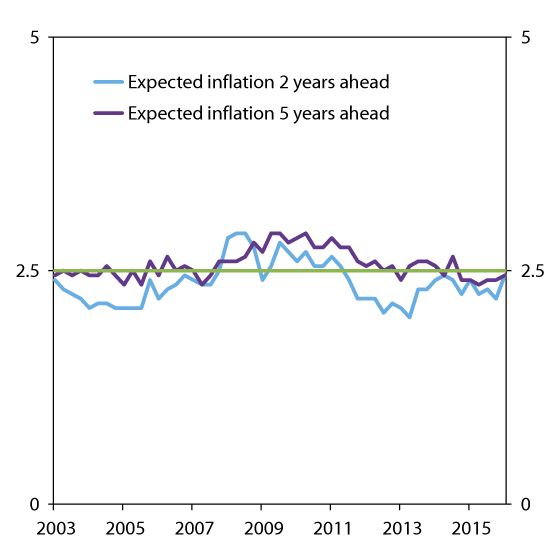
Figure 5.6 Expected consumer price inflation 2 and 5 years ahead.2 Percent. 2003 Q1 – 2016 Q1 1
1 Figure 5.6 is identical to Figure 2.2 in Norges Bank’s Monetary Policy Report 1/16.
2 Average of the expectations of social partners and economists in the financial industry and academia.
Source Norges Bank
Norges Bank uses measures including a calculated output gap to express its assessment of total capacity utilisation in the economy. The output gap illustrates deviations between mainland Norway GDP and a calculated normal level. Figure 5.7 shows Norges Bank’s calculated output gap and the variation in the output gap from 1982 to 2015. In its 2015 Annual Report, Norges Bank wrote that, by this measure, fluctuations in the economy have been reduced over time.
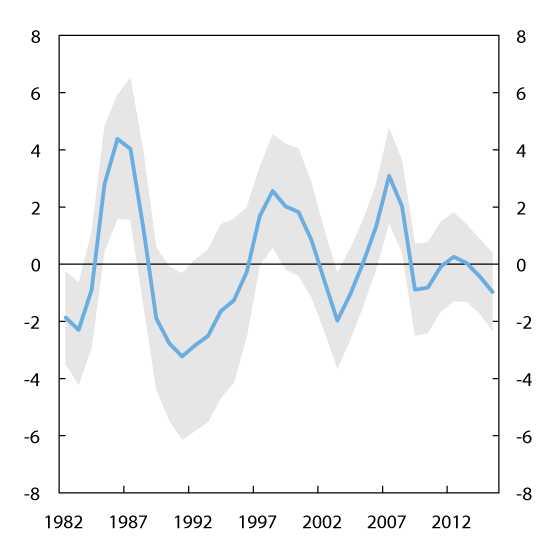
Figure 5.7 1 Estimated output gap2. Level and variation3. Percent. 1982 – 2015
1 Figure 5.7 is identical to Figure 1.4 in Norges Bank’s annual report for 2015.
2 The output gap measures the difference between GDP and the calculated potential mainland Norway GDP.
3 The band indicates variation in the output gap measured by +/– one standard deviation. The standard deviation is calculated over a ten-year period.
Source Norges Bank
Considerable uncertainty attaches to the calculation of the output gap. Norges Bank Staff Memo 8/12 stated the following, among other things:
Potential output is not observable and has to be estimated. There is thus uncertainty surrounding the output gap not only today and ahead, but also historically. Sources of uncertainty are whether the model chosen is appropriate for estimating potential output and the output gap (model uncertainty), the parameters in the various approaches have to be projected or estimated (parameter uncertainty), and the historical figures and the estimates on which the output gap is based may be revised ex post (data uncertainty). For example national accounts are often revised.
Norges Bank therefore considers that other indicators must also be employed when evaluating capacity utilisation in the economy. Examples of such indicators include developments in unemployment, employment and capacity utilisation reported by Norges Bank’s regional network.
5.6 Other parties’ assessments of Norges Bank’s conduct of monetary policy
Several reports have been made on how monetary policy in Norway has been applied in the period following the presentation of the Financial Markets Report 2014 in April 2015. The following section briefly discusses the assessments in the following reports:
“Norges Bank Watch 2016”, a report by a group of experts appointed by the Centre for Monetary Economics (CME) at BI Norwegian Business School. The Ministry of Finance contributes in the funding of these reports
The OECD’s country report on Norway, which was published on 18 January 2016.
The IMF’s report from September 2015, which was prepared in connection with an Article IV consultation.
“Økonomisk utsyn over året 2015” (Economic perspectives 2015) by Statistics Norway, which was published on 10 March 2016.
The Norges Bank Watch report includes the following assessment on Norges Bank’s conduct of monetary policy in 2015:
On the surface, monetary policy execution has been very successful this year. The Norwegian currency weakened sharply in 2013 and 2014, and this has continued during the year. The downturn has not markedly spread to industries and regions not directly hit by the oil price tumble, but we do not know to what extent this is a result of monetary policy or simply is the result of currency markets reacting to the weaker prospects of the Norwegian economy.
While we applaud the gradual lowering of the interest rate itself and the interest rate forecast path, we have some critical remarks on Norges Bank’s communication with the public during the year. This has both to do with the communication given more continuously in monetary policy reports and otherwise, but we also wonder about to what degree Norges Bank’s mandate and the Bank’s own interpretation of the mandate in policy making enlightens us about what to expect when the economy enters uncharted terrain.
The Norges Bank Watch group is critical of Norges Bank’s monetary policy communications in connection with certain interest rate meetings in 2015. This applies particularly to the March meeting, when market participants and analysts expected Norges Bank to reduce the key policy rate but the rate was instead kept unchanged. The group comments as follows:
It is hard to avoid the conclusion that 2015 was a bad year for Norges Bank in terms of predictability and consistency. It made a decision in March which few understood and no one foresaw. The meeting made it clear that shifts in risk assessment are not possible for outsiders to follow.
The group has put forward several proposals for improving monetary policy communications. For example, the group takes the view that, in connection with meetings after which no monetary policy report is published, Norges Bank should state more clearly whether new information indicates higher or lower future interest rates. The group also considers that information about whether the bank considered making a different decision at an interest rate meeting should be published in writing, not simply be provided orally at the press conference.
The Norges Bank Watch group is also of the opinion that adopting a more explicitly formulated monetary policy mandate could help to make monetary policy more foreseeable. The group has discussed whether the mandate should define more explicitly how structural shocks and temporary disruptions are to be dealt with in the monetary policy context. Theoretically, there are good reasons why monetary policy should aim to stabilise domestic inflation. Nevertheless, the group argues that the forward-looking inflation target should be linked to consumer prices, as at present. The group’s arguments include that a consumer price inflation measure is easier to communicate, and that it is difficult to split inflation into a foreign and a domestic component. Monetary policy should nonetheless be applied in such a manner that total inflation may deviate from the inflation target for a period when the economy is hit by structural shocks and temporary disruptions. The group argues that, in the present situation, it is sensible for monetary policy to permit a considerable proportion of the adjustment of the real exchange rate to lower oil prices to occur through krone depreciation and temporary higher inflation. In the report, the group writes the following:
We think – 15 years after the current macroeconomic regime was introduced in Norway – it is time to evaluate the mandate and see if it needs to be reformulated. As mentioned, we think the current price flexible interpretation of the mandate is sound in the present economic circumstances. Norges Bank states that it will abstract from “temporary disturbances” when setting its policy rate. Supply-driven high or low inflation lasting a few years, as the low inflation following the China-shock and today’s oil-price shock, could perhaps be denoted temporary disturbances. A sharper formulated mandate could make monetary policy more predictable, and the impact of monetary policy on the economy is often thought to depend critically of the public to anticipate future policy.
According to the group, Norges Bank exercises excessive discretion in taking robustness and financial stability into account when setting the interest rate path. In this regard, the group considers that the monetary policy mandate should be amended to state more clearly whether and how monetary policy should promote financial stability and robust economic development. The group also questions whether the inflation target should be reduced from 2½ to 2 percent.
In its most recent Economy Survey of Norway, which was published on 18 January 2016, the OECD writes the following:
Norway’s flexible inflation-targeting regime has a good track record in delivering low and stable inflation. In parallel with many economies, the policy rate has been notched down in recent months; as of September 2015 the policy rate has been 0.75%. Within the current macroeconomic context, both globally and domestically, this further monetary easing has been warranted, reflecting renewed fears about the strength of the global economy generally, and in particular for Norway, in view of the oil price declines. There remains further room to manoeuvre. Inflation is temporarily boosted by currency depreciation but otherwise is contained by remaining economic slack and inflation expectations appear well anchored. Monetary policy should therefore remain supportive for some time, but eventually tighten when growth picks up further.
The IMF has commented as follows in a September 2015 report linked to an Article IV consultation:
Directors supported the current monetary policy stance, while urging a careful monitoring of inflation and financial stability risks. They agreed that monetary policy should be the first line of defense if growth turns out significantly weaker than projected, as long as inflation expectations remain well anchored. They recommended the timely implementation of macroprudential measures to contain rising household credit, in order to leave room for monetary policy to support growth while pursuing the inflation target.
In “Økonomisk utsyn over året 2015” (Economic perspectives 2015), Statistics Norway states that the key policy rate was reduced twice in 2015 and that money market rates are at record lows. It also stated that:
Increasingly expansionary monetary policy is also an important reason why the decline has not been greater. Combined with the fall in oil prices, lower interest rates have contributed to the krone’s depreciation by almost 30 percent from its peak at the start of 2013 until the end of last year. This entails a major improvement in cost competitiveness, which in turn is easing the situation for all Norwegian businesses competing internationally.
Financial stability is discussed further in chapter 2 of this report.
5.7 The Ministry’s assessment
The monetary policy guidelines were adopted on 29 March 2001, and there was broad agreement in the Storting on these. Market participants, academics and the general public all appear to have confidence in Norwegian monetary policy. Norges Bank is mandated to exercise case-by-case discretion within the framework of the guidelines. In the Ministry’s view, the division of responsibility between the political authorities and Norges Bank achieves the desired purpose.
The Ministry is of the opinion that the framework for Norges Bank’s conduct of monetary policy is reliable and has proven itself to be robust even during the financial crisis. The guidelines enabled Norges Bank to cut interest rates sharply when inflation expectations and output dropped in the autumn of 2008. Expansionary monetary policy helped to stabilise the development of the Norwegian economy. The framework is highly consistent with practice in other countries which employ flexible inflation targeting
The framework has also coped well with the sharp drop in oil prices since June 2014. Norges Bank reduced the key policy rate to 0.75 percent in 2015, and further to an all-time low of 0.50 percent in March 2016. Combined with falling oil prices, these interest rate cuts have caused a marked depreciation of the krone and improved the competitiveness of Norwegian businesses. These developments have helped curb the slowdown in the Norwegian economy’s growth rate and rising unemployment.
In April 2015, an official commission was appointed to consider modernisation of the Norges Bank Act. The commission is due to deliver its report by 10 April 2017. Parallel to the commission’s work, the Ministry will evaluate the need to modernise the Regulation on Monetary Policy.
The Regulation states that Norges Bank’s implementation of monetary policy shall be oriented towards low and stable inflation, defined as annual consumer price growth of approximately 2.5 percent over time. In the short and medium term, monetary policy shall balance the objective of low and stable inflation with the objective of stable output and employment.
Monetary policy is the first line of defence in the context of stabilisation policy. Monetary policy instruments can quickly be changed if the economic outlook changes.
Monetary policy must be forward-looking. Norges Bank sets the interest rate with the aim of stabilising inflation close to the 2.5 percent target in the medium term. The time horizon depends on the disruptions to which the economy is exposed, and on what effects such disruptions have on inflation and the real economy looking forward. In its conduct of monetary policy, Norges Bank is required to balance the objective of stable inflation with the objective of stable output and employment in the short to medium term.
When evaluating price trends over time, the key measure is the development in total CPI. Over the past 15 years, inflation has averaged out at somewhat less than, but close to, 2.5 percent. Increased global division of labour has resulted in low growth and, at times, falling prices for imported consumer goods during this period. This has strengthened the purchasing power of Norwegian households and helped maintain profitability among Norwegian businesses.
There appear to be firm expectations that inflation will be close to target for several years to come; see section 5.5 above. Such confidence in the inflation target makes it easier for Norges Bank to contribute to stability in output and employment.
Total CPI development varies significantly from year to year, not least due to large fluctuations in electricity prices. When assessing current inflation and the future outlook, therefore, CPI does not provide the best assessment basis. Underlying inflation cannot be observed directly, and must thus be calculated. Norges Bank uses several indicators to obtain a picture of underlying inflation. Consumer prices adjusted for tax changes and excluding energy products (CPI-ATE) is a key index. Norges Bank also calculates the CPIXE index, which has methodological similarities to CPI-ATE but takes account of trends in the development of energy prices. No single indicator can provide a complete answer to the question of what underlying price inflation is or will be in the near future. Using several different indicators of this quantity, as Norges Bank does, helps to improve the assessment basis.
The Norwegian krone has depreciated markedly in recent years. Measured by the import-weighted krone exchange rate, the krone weakened by 5.1 percent in 2014 and 9.4 percent in 2015. The weakening of the krone is linked to the drop in oil prices and the weakened growth prospects of the Norwegian economy. The krone’s depreciation has been supported by Norges Bank’s interest rate cuts. In a floating exchange-rate system, the exchange rate must be expected to vary. This can help to stabilise economic developments and ease economic restructuring. The recent depreciation of the krone has helped improve the situation for enterprises in Norway engaged in international competition at a time when demand from the oil industry has fallen sharply.
Clear communication of the intentions behind the orientation of monetary policy helps to stabilise expectations among participants in the economy. Norges Bank’s publication of its own future interest rate path is important in this respect.
Norwegian monetary policy seeks to be robust and to address the risk of especially unfavourable economic outcomes. Norges Bank has stated that monetary policy should help to counteract the development of financial imbalances. When there is particular uncertainty about future economic developments, it may be right to focus monetary policy on avoiding or alleviating the most unfavourable outcomes. In such situations, more proactive monetary policy may also be indicated.
Robustness is not an independent objective, but Norges Bank emphasises that robustness may lead to a better development in inflation, output and employment over time.
Responsibility for the safeguarding of financial stability is shared between the Ministry of Finance, Norges Bank and the Financial Supervisory Authority Of Norway (Finanstilsynet). Norges Bank and Finanstilsynet are charged with verifying that the financial system is robust and efficient, and therefore monitor financial institutions, securities markets and payment systems to identify stability threats. Norges Bank is the lender of last resort for banks. Norges Bank is mandated to prepare a decision-making basis and advise the Ministry on the size of the counter-cyclical capital buffer requirement for banks. The bank does this through both its quarterly monetary policy reports and separate letters of advice to the Ministry. The Ministry of Finance has no comments on the form of the decision-making basis or the way in which Norges Bank explains its advice relating to the counter-cyclical capital buffer requirement for Norwegian financial institutions. Chapter 2 of this report contains further discussion of financial stability efforts. The counter-cyclical capital buffer is discussed in Box 2.4.
To allow households and other participants in the economy to make appropriate adjustments, it is important that Norges Bank provides clear information on its monetary policy assessments. The bank has published its own interest rate projections since the autumn of 2005. The bank has attracted international attention due to its transparency and reliable communication of the assessments behind the application of monetary policy. Norges Bank also reports on the factors emphasised by the Executive Board when preparing interest rate decisions. The Ministry considers that, overall, Norges Bank communicates assessments relating to the use of monetary policy instruments clearly.
The Ministry sees no grounds for commenting on Norges Bank’s conduct of monetary policy in 2015.